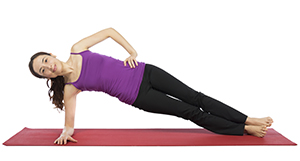 Planks are the new standard core strengthening exercise that have replaced the sit up. As you may recall from Dr. Shillingford’s previous post on planks (see that blog here), although planks are a stationary exercise they can help strengthen muscles in your arms, shoulders, glutes, and your abdominal muscles all by holding a position. If you’ve been cleared by Dr. Shillingford to exercise after your gastric sleeve, gastric bypass, or lap band surgery and need a refresher on how to do a plank, please go back and read the plank blog.
Planks are the new standard core strengthening exercise that have replaced the sit up. As you may recall from Dr. Shillingford’s previous post on planks (see that blog here), although planks are a stationary exercise they can help strengthen muscles in your arms, shoulders, glutes, and your abdominal muscles all by holding a position. If you’ve been cleared by Dr. Shillingford to exercise after your gastric sleeve, gastric bypass, or lap band surgery and need a refresher on how to do a plank, please go back and read the plank blog.
If you’ve been incorporating planks into your exercise routine after your bariatric surgery and are looking to step it up a notch, you can try a different variation on the plank. In this blog, we’ll focus on the side plank.
Basic Side Plank
- Lie on your side with your legs extended out in a straight line
- Prop yourself up on your forearm (your elbow should be bent so that your hand and forearm are at a right angle to your body)
- Keep your legs together so your feet rest one on top of the other (you should be balancing on the side of your foot, not the sole)
- Place your other hand on your hip
- Contract your core muscles
- Hold this position for 1 minute
- Repeat on the other side
It’s important to maintain the proper positioning. Do not let your hips dip low to the floor, maintain your body in a diagonal line. If you can’t maintain the side plank position for 1 minute, start with trying for 15 seconds and work your way up to a minute. If you can already hold the side plank position for 1 minute, try to work your way up to 2 minutes.
Planks strengthen your core muscles and each variation helps target different muscle groups so it’s good to add different versions to your fitness repertoire. The side plank is specifically good for improving balance and concentration in addition to really working those core, back, and leg muscles.
Planks are a good muscle strengthening exercise for people who are overweight or obese for a couple of reasons. First, you can do them at home. This means no one will be watching or judging you on how you look or how long you can hold the position. Second, you can do them multiple times a day. Challenge yourself to do them before each time you eat, or each time a commercial comes on. Third, they will be a challenge as you will have to hold your own body weight. For this reason, planks may be harder for obese and overweight exercisers than for those with a normal BMI. That means that as you hold each plank for longer, you are strengthening your muscles at an incredible rate. Fourth, more lean muscle mass means you burn more calories when at rest, which ultimately helps with weight loss. And lastly, as you improve the length of time you can hold each plank position, your self confidence will grow and you will feel stronger in both body and mind.
The above is offered by Dr. Shillingford, MD, PA, a Boca Raton based board certified surgeon specializing in advanced laparoscopic and weight loss surgery. Dr. Shillingford’s gastric sleeve, gastric bypass, and lap band patients are encouraged to incorporate exercise and strength training into their post bariatric surgery lifestyle (after an appropriate amount of time and have been cleared to exercise by Dr. Shillingford). If you or a loved one are considering bariatric surgery, attend one of Dr. Shillingford’s free informational sessions to learn which surgery- gastric sleeve, gastric bypass, or lap band- is a right fit for you. Call Dr. Shillingford at (561) 483-8840 to schedule your free informational session today.

 Am I A Candidate
Am I A Candidate  BMI Calculator
BMI Calculator  Why Choose Us
Why Choose Us